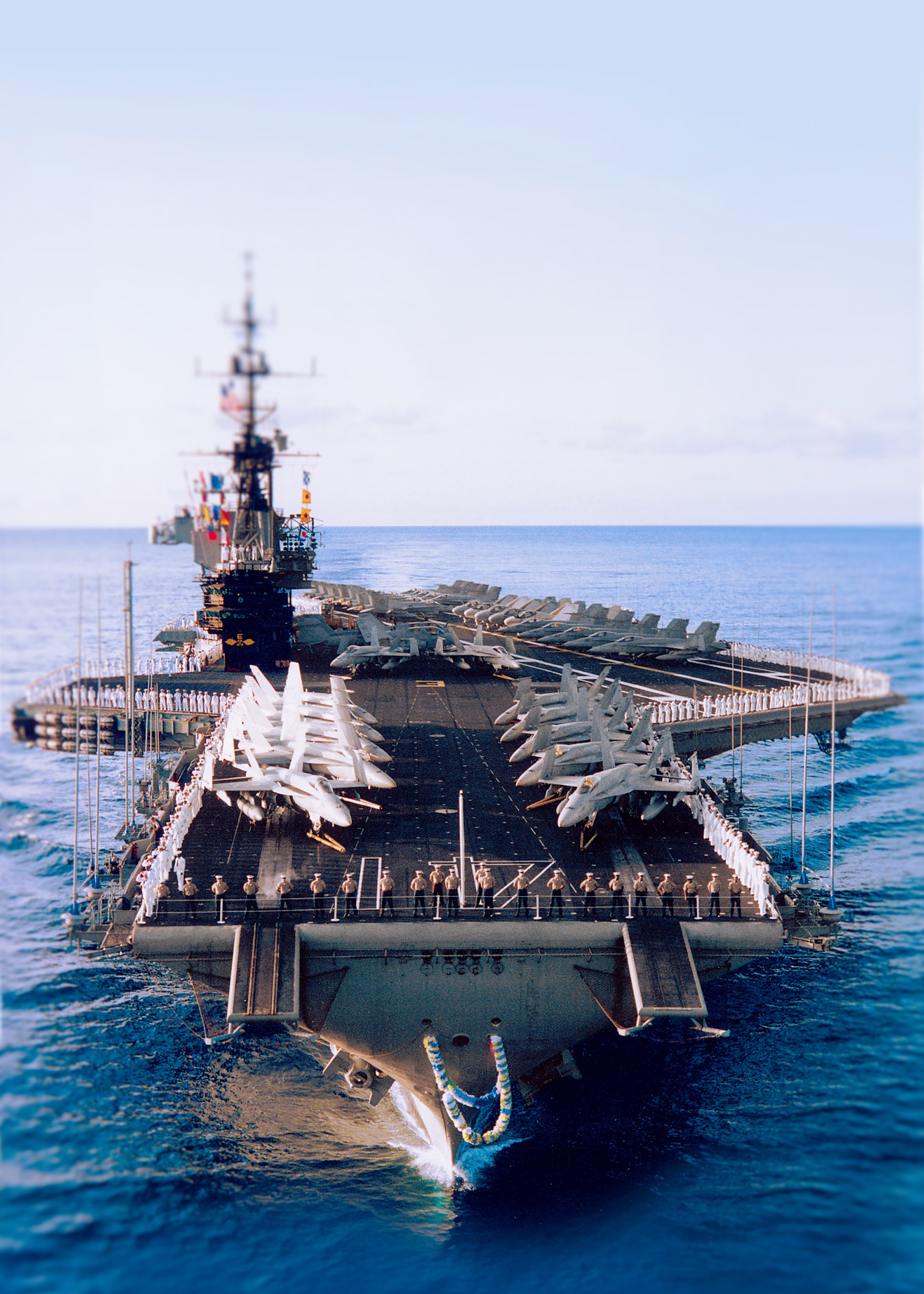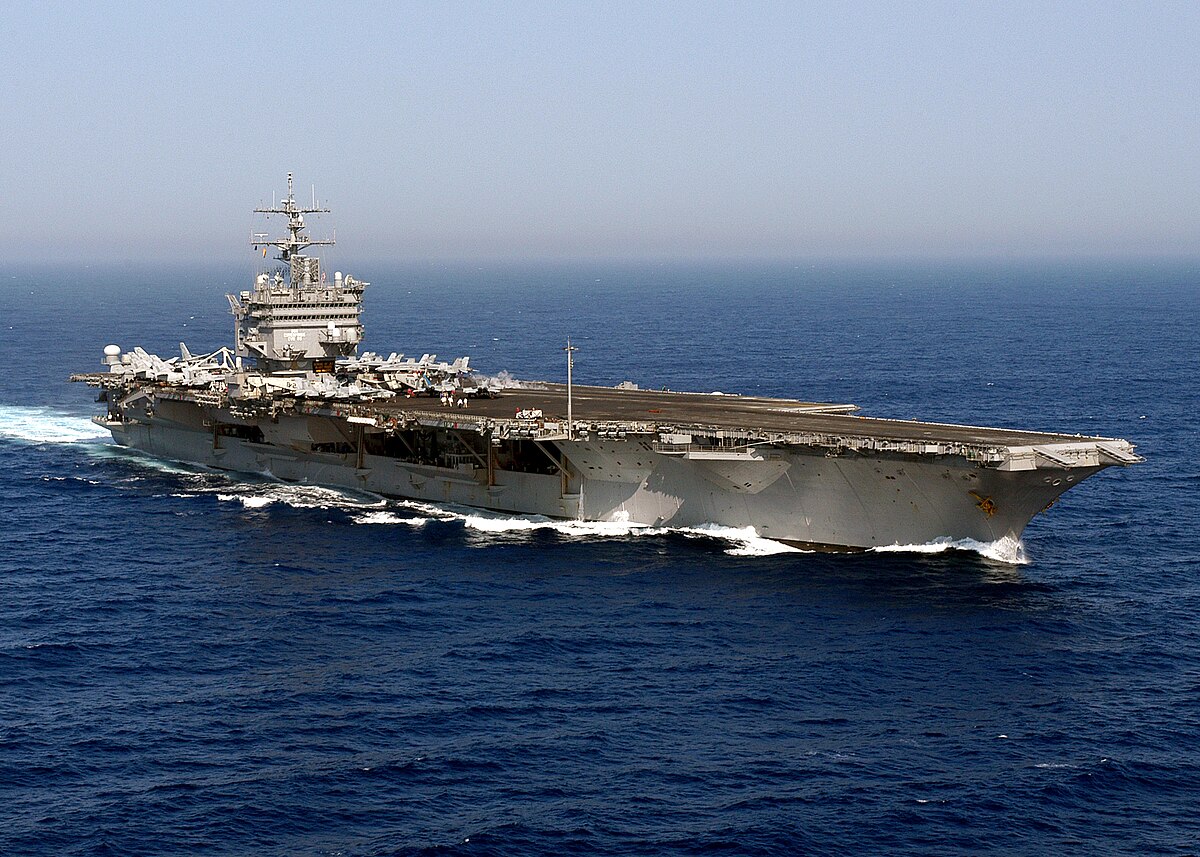Aircraft Carrier Midway - USS Midway (CVB/CVA/CV-41) is a former United States Navy aircraft carrier, flagship of its class. Commissioned 8 days after World War II, Midway was the world's largest aircraft carrier until 1955, and the first US aircraft carrier to transit the Panama Canal. She served for 47 years, during which time she saw the war in Vietnam and served as the Persian Gulf flagship during Operation Desert Storm in 1991. Launched in 1992, it is now a museum ship at the USS Midway Museum, San Diego, California, and is the only carrier in the US. defunct non-Essex airline.
Midway was laid down on 27 October 1943 at Shipway 11 by Newport News Shipbuilding Co., Newport News, Virginia; It was launched on March 20, 1945, Mrs. Bradford William Ripley, Jr.; and was commissioned on 10 September 1945 (eight days after the surrender of Japan) with Captain Joseph F. Bolger in command.
Aircraft Carrier Midway

After a stint in the Caribbean, Midway entered the US training program. Atlantic Fleet, Norfolk became its home port. From February 20, 1946, he was the commander of the 1st Carrier Division. In March, he participated in Operation Frostbite to test the Ryan FR Fireball and helicopter rescue techniques for cold weather operations in the Labrador Sea. In September 1947, the German V-2 rocket was tested during Operation Sandy from an airfield, the first major rocket launched from a mobile platform and the only mobile launch platform for the V-2. As the rocket took off, it tilted and broke up at 15,000 feet (4,600 m).
Uss Midway Aircraft Carrier Museum In San Diego
On 29 October 1947, Midway departed with the 6th Fleet on its first annual deployment to the Mediterranean. Between deployments, the Midway was trained and received modifications to carry heavier aircraft as it was developed.
In June 1951, Midway operated in the Atlantic near Cape Virginia during airworthiness testing of the company's F9F-5 Panther. On June 23, Cdr. George Chamberlain attempted to land Duncan BuNo 125228, a rearward landing caused Duncan to crash. The fuselage of the forward plane broke off and fell to the ground, burning. Footage of the crash has been used in several films, including M of the Fighting Lady, Midway and The Hunt for Red October.
In 1952, the ship took part in Operation Mainbrace, maneuvers with NATO forces in the North Sea. Midway painted an angled runway in flight in May, following initial tests of the HMS Triumph boarding strategy for touch-and-go. A successful demonstration of the possibilities led to widespread adoption of the angled flight deck in future airline designs and modifications of existing carriers.
Midway departed Norfolk on 27 December 1954 on a world cruise from the Cape of Good Hope to Taiwan, where she served as the first large carrier of the 7th Fleet until 28 June 1955.
Uss Midway Cv 41
In this operation, Midway pilots flew a plane to evacuate the Tach Islands during the Quemoy-Matsu disaster.
The conflict arose during the Midway cruise to Cape Town (South Africa). Democratic Alliance spokesman Herbert Lehman sent a call to Secretary of the Navy Charles Thomas when he learned of the United States Navy's alleged plan to separate 400 non-white crew members from Midway while in Cape Town. Democrat member Hubert Humphrey soon joined Lehman, writing a letter to Secretary of State John Foster Dulles, "demanding that immediate action be taken to ensure that American laborers are given equal treatment and that leave to land in South Africa be allowed, or that the Cape Town be abandoned as a port of destination." " ", and saying "To me this is a terrible act of racism that our Government should not accept. Every American soldier or sailor is an American regardless of race, color or creed, and has one. the right to be respected and treated as such anywhere in the world."
An anonymous Navy official said the Navy Department was unaware of any agreements to be made between Midway officials and South African authorities, and that African-American crews would not be distributed while on Midway.

Clarence Mitchell Jr. he also demanded that Thomas not allow Midway to set up a booth in Cape Town. James H. Smith Jr., the Secretary of the Navy at the time, responded that the stopover in Cape Town was merely to "satisfy a cargo operation requirement" and was typical of local rules and regulations when visiting foreign ports.
File:uss Midway (cv 41) Bow View C1983.jpeg
Midway Captain Reynold Delos Hogle said that while in port, Midway will be United States territory and United States federal laws will apply. At the event, the Midway band did not go along with apartheid, as Captain Hogle said, "At the Hartleyvale (stadium) concert this evening and tonight, Europeans and non-Europeans have been asked to attend . . . no distinction."
On 28 June 1955, the ship departed for Puget Sound Naval Shipyard, where Midway underwent a modernization (SCB-110, similar to SCB-125 of the Essex-class carriers). Midway received an enclosed storm bow, deck elevator, angled flight deck and steam catapults before returning to final service on 30 September 1957.
Home built in Alameda, California, Midway began its annual deployment carrying McDonnell F3H Demons, North American FJ-4 Furys, Vought F-8 Crusaders, Douglas A-1 Skyraiders and Douglas A-3 Skywarriors to the 7th Fleet in 1958. and the South China Sea during the spring 1961 Laotian crisis. During the 1962 expansion, Midway had its 100,000. he registered the arrest.
As the aircraft carrier tests the air defense systems of Japan, Korea, Okinawa, the Philippines and Taiwan. Midway again sailed for the Far East on 6 March 1965, and from mid-April began strikes against military installations and supplies in North and South Vietnam, including the first use of AGM-12 Bullpup air-to-surface missiles. Two VF-21 McDonnell Douglas F-4B Phantom IIs flying over Midway on 17 June 1965 were the first confirmed MiG kills of the Vietnam conflict, using AIM-7 Sparrow missiles to shoot down two MiG-17Fs. Three days later, four A-1 Skyraiders from Midway used the classic World War II Thach Weave maneuver to down an attacking MiG-17F.
The U.s. Navy Loved The Midway Class Aircraft Carrier. This Is Their Story.
Midway lost an F-4 Phantom and two A-4 Skyhawks to North Vietnamese S-75 Dvina surface-to-air missiles before returning to Alameda on 23 November to begin modernization at Naval Shipyard San Francisco Bay (SCB) on 11 February 1966. -101.66), which was dangerous and controversial. The aircraft deck was enlarged from 2.8 to 4 hectares (11,300–16,200 square meters (122,000–174,000 sq ft)), and the flight seat angle was increased by 13.5 degrees. The lifts were large, mobile and provided almost double the weight capacity. Midway also received new catapults, harnesses and air conditioning. Cost overruns raised the project's price tag from $88 million to $202 million, and prevented similar improvements planned by Franklin D. Roosevelt. After Midway was finally recertified on January 31, 1970, it was found that the modifications had impaired the ship's water-holding capacity and ability to perform wind operations in rough seas, requiring additional modifications to correct the problem.
Midway returned to Vietnam and on 18 May 1971, after relieving Hancock at Yankee Station, began a single mission. Midway departed Yankee Station on June 5, completed her final voyage on October 31, 1971, and returned to port on November 6, 1971.
Midway, with Carrier Air Wing 5 (CVW 5), again departed Alameda on 10 April 1972 for operations in Vietnam. On May 11, planes from Midway, along with those from Coral Sea, Kitty Hawk, and Constellation, began laying sea mines. Ports in North Vietnam, including Thanh Hóa, Đồng Hới, Vinh, Hon Gai, Quang Khe and Cam Pha, and other routes to Haiphong. Ships in Haiphong harbor were warned that mines would be laid and that they would be armed within 72 hours.

Midway continued operations in Vietnam during Operation Linebacker during the summer of 1972. On August 7, 1972, an HC-7 Det 110 helicopter, flying from Midway, and supported by carrier and Saratoga aircraft, searched for the A-7 pilot. A Corsair II from Saratoga, shot down by a surface-to-air missile the day before, 20 mi (32 km) inland, northwest of Vinh. Flying over the mountains, the HC-7 helicopter spotted the downed aircraft with its light and, under heavy fire, recovered it before returning to LPD along the coast. This was the deepest request for a helicopter for North Vietnam since 1968. In 1972, HC-7 Det 110 rescued a total of 48 pilots in 35 combat situations.
Behold The Uss Midway, The Largest Aircraft Carrier In The World You Can Tour
On 5 October 1973, Midway entered Yokosuka, Japan with CVW 5, making the first deployment of an entire carrier group to a Japanese port, the result of an agreement reached by the US on 31 August 1972.
Midway aircraft carrier, battle of midway aircraft carrier, the midway aircraft carrier museum, midway aircraft carrier museum tickets, midway aircraft carrier museum, uss midway aircraft carrier museum, midway aircraft carrier history, san diego midway aircraft carrier, midway class aircraft carrier, uss midway aircraft carrier, midway aircraft carrier tickets, midway aircraft carrier tour
0 Comments